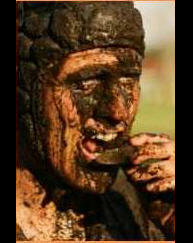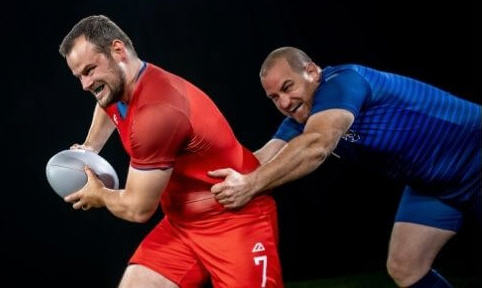What is the easiest position to play in rugby? This question leads to a lot of jokes and banter between teammates.
However, it can be answered with reasonable arguments. And a little bit of tongue-in-cheek.
At the elite and international levels, these arguments don’t really apply. It’s not easy pulling off the outrageous skills of a winger like Cheslin Kolbe! This article is about the non-elite levels of rugby.
What Is The Easiest Position In A Rugby Match?
At the non-elite level, winger is the easiest position on the pitch. Wingers, as their name implies, are the farthest back and the nearest to the sidelines.
The winger’s job is to finish the play. Their role is to be in the clear to receive a pass and run like crazy with the ball after all the other players have done the hard work of getting it to them.
Playing rugby for the first time
Most rugby players are introduced to the sport in school, but most amateur clubs have a big welcome for beginners who are reasonably fit. Check out our article on what you need to start playing rugby. You will also find our introduction to rugby positions useful.
Players who are new to the sport are often put out on the wing in practice matches and their first competitive outings. It’s the best place to watch play unfold without being too involved!
Wingers have to do the least and therefore will mess up the least while they are still trying to figure out the game.
Winger duties
All you have to do is chase kicks, defend your line, and run at top speed if the ball happens to make its way back to you.
There is no getting into the sweaty, exhausting ruck or maul for the winger. He or she gets to stand back and see what happens.
Wingers also do not need to make hard strategic decisions about who to distribute the ball to. They just need to get clear of the opposition and run down the field as fast as they can.
Perfect hair
The stereotypical winger leaves the pitch with a spotless jersey while their teammates are caked in mud.
Here is a typical forward:

In contrast, wingers enter the changing rooms without a single perfectly coiffed hair out of place.

One forward once said that a winger can run around for an entire match without actually playing any rugby.
Did I say “one forward”? I meant every forward who has ever played the game.
Why Wing Is The Easiest Position In Attacking Play
I said I’d give some reasonable arguments, so let’s break this down between attacking and defensive play.
The winger has it easiest in attacking play because he’s farthest from the ball. Being far from the ball, he’s least likely to have to initiate a play after the ruck.
Since a winger’s role is to be a finisher, many plays will never even get to them. The ball may be lost or the opposing team may make successful tackles earlier in the play.
You’ll often hear a television commentator exclaim that a winger has touched the ball for the first time in the match. This could be in the 39th minute, particularly in wet conditions.
Wingers in wide attacks
But what if the ball reaches the winger in a flowing attack that moves the ball across the back line?
Thankfully for our surprised winger, most of the hard work has already been done by his teammates. They’ve somehow kept the ball alive for long enough that the winger can enter the play.
All you have to do is:
- run along in support (don’t overrun past your teammates!)
- don’t drop the pass
- if you get the pass, keep running to the end of the field
- look nonchalant as you dot the ball down for a try
(There’s a bit more to it in that. Check out our totally serious article on the role of wingers in rugby if you want less fun than you get here).
General attacking duties
The winger’s role of chasing kicks isn’t the most complex task on the pitch. (I don’t want to point out that a chihuahua could do it, so I won’t!).
Since the winger is the widest player in the formation, he is generally the last receiver of the ball. This means that wingers do less passing than any other position on the field.
Waiting game
Most of what a winger does in the attacking play is to wait:
- wait for the ball to come back
- wait for the play to develop
- wait for the pass if another player needs to offload.
In fact, the role can be summed up in the 17th century words of one of the great poets.
They also serve who only stand and wait.
John Milton
Why Wing Is The Easiest Position To Defend
Wing is the easiest position in defensive play due to the position on the pitch. Wingers are to the back and outside and farther away from the ball from anyone.
The opposition’s attacking plays often don’t even reach the winger. In order for a winger to have to make a tackle, the attacking teams usually have to move the ball through three or four players.
Since wingers are among the last defenders, most tackles are made before the winger even has to involve themselves in the play. This is why wingers make the fewest tackles per game of anyone else on the team.
Stats, anyone?
That’s a strong statement to make, so can I back it up? We have a separate article on how many tackles the different rugby positions make. Wingers in professional rugby make an average of three tackles per match.
However, I want to focus here on the non-elite players at amateur level.

So, I checked with several people I know who played wing in college or for an amateur club. I asked them how many tackles they made in a match.
The general answer was three or four per match. That could be less if a game was played in poor weather conditions. There were far more scrums from knock-ons than the winger making a tackle.
One guy sheepishly told me that he had gone through a season without making a tackle. His club team was so dominant that the opponents couldn’t break the defensive line.
But he cheered up when he remembered how many tries he scored!
Easier tackles
If the winger does find himself in the unusual position of having to make a tackle, he has it easier than most of his teammates.
This is because wingers are usually running down someone from behind.

You aren’t in danger of looking foolish as your opposing wing side-steps you, leaving you tackling fresh air.
And if you do make the tackle from behind, you’re not taking the punishing hit of a front-on tackle where the player runs into you at full speed.
Nor do you have to worry about some large human being falling on you when you tackle from behind; the ball carrier will fall forward and you will land on top of him, not the other way around.
The sideline as your best friend
Finally, the winger has the sideline as an aid. This really limits where the ball-carrier can go and in which direction they can turn.
A favorite mantra of coaches is that the sideline is the best defender on the pitch.
Easy Vs Hard
We’ve covered the easiest position, but what about the other end of the spectrum?
Check out our article on what is the hardest position in rugby. You may be surprised!